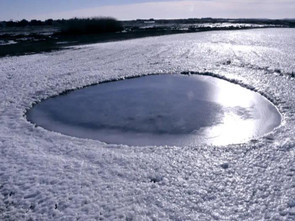As winter blankets the landscape with beautiful snow and frigid temperatures, the once vibrant fish pond undergoes a transformative chill. The frozen pond harbors challenges that require thoughtful consideration, particularly when it comes to the well-being of the aquatic life and valuable fish within. The role of a diffused pond aerator becomes paramount, acting as a lifeline to maintain healthy oxygen levels in the pond's ecosystem.
A pond aerator is not just a winter accessory; it's a critical component to ensure the survival of fish and maintain a healthy aquatic environment. During the winter freeze, a pond aerator serves a dual purpose: keeping an area of the pond's surface open (and not frozen over) to allow fresh air and oxygen to enter while providing a vital exit hole for toxic gases from decomposing organic matter to escape. Without this ventilation, harmful gases will accumulate, posing a threat to pond and fish life.
Pond aerators also work by physically keeping a portion of the pond's surface open and not frozen over. This is caused by the water movement the air diffusers - or air bubblers - that are placed on the bottom of the pond provide. So, not only is fresh oxygen entering the pond in deeper waters but the water's movement is helping to create an exit hole for toxic gases to escape. So, that's a win-win-win situation for using a pond aerator in the cold winter months.
Large pond owners may sometimes delay investing in a pond aerator, hoping that the existing pond oxygen levels can sustain the fish population. However, fish populations typically increase year after year and so do the needs of the oxygen they require. Without using a proper sized aerator during the winter, this gamble of leaving the pond to freeze over often leads to a harsh reality with a significant fish kill that becomes evident as the ice thaws. To avoid such distressing scenarios, it's prudent for pond owners to invest in a properly sized and placed aerator, providing a reliable source of oxygen throughout the winter months.
As far as placement of an air bubbler or air diffuser that sits on the bottom of the pond, this should be placed around a 5-6' deep area, providing that is not the deepest area of your pond. Given that temperatures vary in different parts of the world during the winter, try to place your diffuser(s) where you can move it, if needed. (You may be able to attach a nylon rope around it and have the end of the rope near the edge of the pond. Depending on the aerator compressor, there may be a valve on it to adjust air flow. Sometimes, the hole can get quite small given many single digit days in a row. Other days, the hole in the ice may be much larger. It's wise to keep your eye on it and either adjust the placement of the diffuser or the air flow to it. Most air compressors require protection from the elements too including wind, rain, snow, ice, etc. Make sure your cover for it is well ventilated so the compressor doesn't overheat and burn out and that it can get fresh oxygen to push into the pond water. A GFCI circuit is required for all outdoor outlets as well and should be used for indoors, too.
For shallow areas in ponds and lakes around boat dock pilings, specialized boat and dock deicers can be used to prevent ice damage. They typically work by churning warmer water from near the bottom of the pond up towards the pilings. See manufacturer's directions on how to place them for the greatest effect.
In conclusion - the winter months bring unique challenges to fish ponds, especially when they freeze over. The use of a pond aerator is definitely a wise investment, ensuring the continual health and vitality of aquatic life. Don't let a frozen pond become a threat to your fish; instead, embrace the benefits of pond aeration system for a thriving and resilient aquatic ecosystem year-round.
Optimize your pond's winter survival strategy by exploring our selection of reliable pond aerators and deicers today. Prepare your fish pond for winter and safeguard your aquatic companions through the chilly months. Avoid having a frozen pond with a sheet of ice over it. Instead, be sure to keep an area of the pond thawed and kept open for the health of your pond's ecosystem and the welfare of your valuable pond fish.

